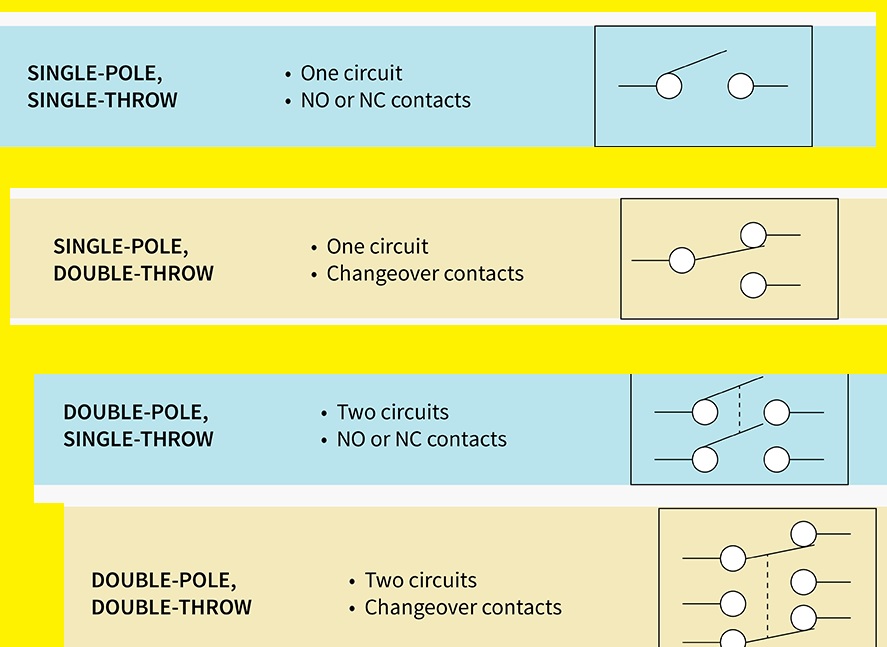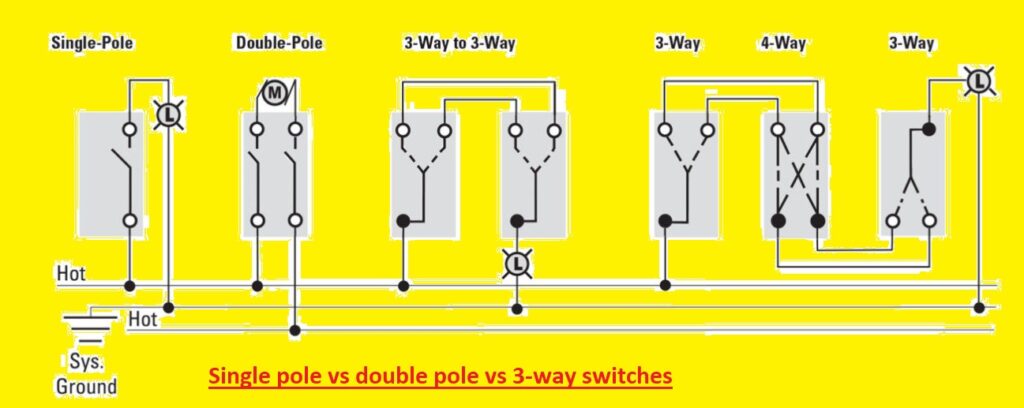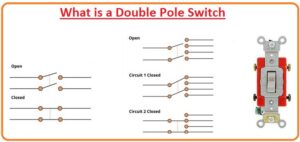 What Is a Double Pole Switch and How Does It Work? Current in two different circuits can be controlled with the use of double pole switches which are the main component of electrical circuits. The operation, definition, and applications of a double pole switch will be explained here. So let’s get started with Double Pole Switch
What Is a Double Pole Switch and How Does It Work? Current in two different circuits can be controlled with the use of double pole switches which are the main component of electrical circuits. The operation, definition, and applications of a double pole switch will be explained here. So let’s get started with Double Pole Switch
Introduction of Double Pole Switch
The double pole switch is an electrical switch that is used for the control of current flow in two separate circuits. it is mostly used in different applications such as homes and for controlling machines in industries. Understanding the working of switches is important to working with electrical circuits.
What is a Double Pole Switch?
A double pole switch is used to control the current in two different separated circuits. it has four templates two work as input and two as output. it is used where 2 separate circuits are controlled distinctly such as a 240-volt circuit.
Understanding Switches
Before going to discuss two pole switch switches it is necessary to understand the bases of different switches. There are three main types of switches
-
- single-pole
- double-pole
- three-way switches.
What Does a Single Pole Switch Mean
- A single pole switch is a switch type that controls current in one circuit It has one input terminal and one output connection
- If the switch is in ON condition circuit is working and current passing through it. In off state switch circuit is open and the current not flowing
- These switches are used in homes and commercial wiring to control lights fans and other appliances connected
- Their prices are lower and they can be easily connected in a circuit than other switches like double pole or three-way switches
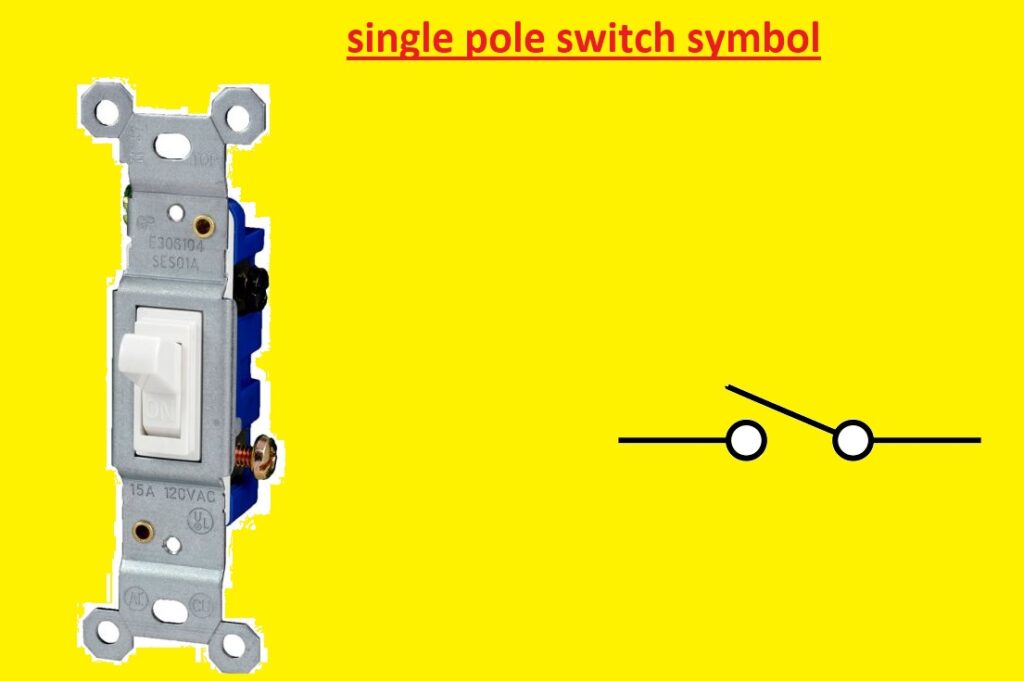
Double Pole Switches
- To control current in two circuits double pole switches are used. it has four terminals two inputs and two used for output circuits
Three-way Switches
- The three-way switch is used to control the current at two different points. it has three pins one used for input and two for output circuits. it is used to control lights from different points such as in the staircase
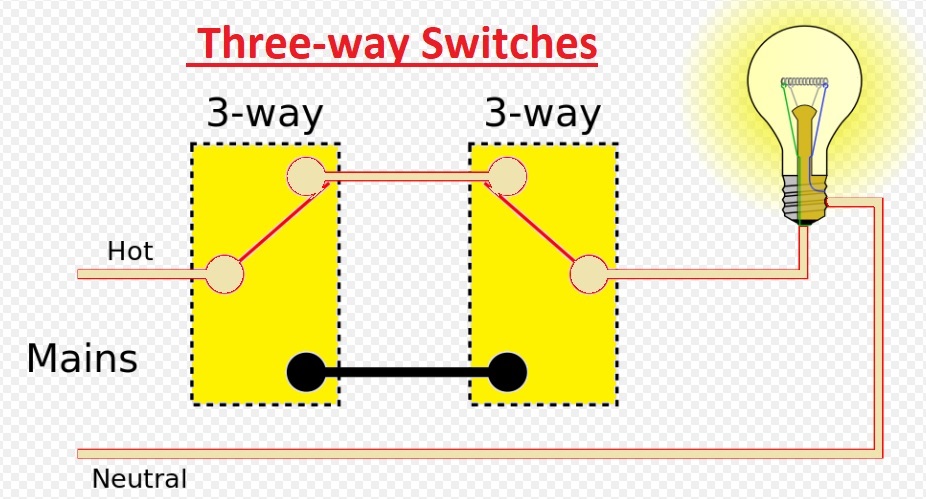
What is DPDT Relay: How does a DPDT Relay Work? its Applications
How Double Pole Switches Work
- The double pole switches or two pole switches controls curent in two different circuits. If the switch is in an ON state current passes through both circuits. When the switch is OFF both circuits are disconnected and 0 current flows
Wiring a Double Pole Switch
- its wiring is like a single pole switch and has two circuits. The input in the circuit is connected to the first termianl pairs and the output circuit is connected with 2nd pair of terminals
Turning On and Off a Double Pole Switch
- Its on and OFF configuration is like the single pole switch. Just flip the switch up to on and flip it down to off. it is good to note that when OFF the double pole switches both circuits are disconnected. During off make sure that both circuits are off
Difference between a pole and a throw
The pole is a circuit that the switch can control for the working of the switch. Throw shows the number of control points. The common types are single-through and double-throw.
- Single pole, Single through = One circuit and NO or NC contact
- Single pole, double through one circuit, and changeover contacts
- Double pole, single throw=No or NC contacts and two circuits
- Double pole, double throw= two circuits changeover contacts
Where Double Pole Switches Are Commonly Used
Double pole switches are used for 2 separate circuits that are required to be controlled independently.
- it is used in homes and buildings where larger wattage devices such as ovens or air conditions are used and operated on 240-volt circuits.
- it is used in industry where larger machines or motors are used on 240-volt circuitry
- In outdoor applications lights and electrical devices are controlled through a switch that protects them from different components
DPST switch Features
| Specification | Value |
|---|---|
| Terminal type | 4.8mm × 0.8mm quick connect solder tail |
| Spacing for insulation | ≥ 8mm |
| Contact gap | ≥ 3mm |
| Dielectric Strength | up to 3.5 kV |
| Contact Resistance | < 20 mΩ |
| Insulation resistance | > 50 MΩ |
| Mechanical life | ≥ 100,000 Cycles |
| Electrical life | ≥ 20,000 Cycles at full load |
| Cut-out size (panel thickness 1mm) | 19.3mm × 13mm |
| Minimum panel thickness | 1mm |
| Maximum panel thickness | 3mm |
| Cut-out size (panel thickness 3mm) | 19.5mm × 13mm |
| Double-Pole (Max) | 10 |
| Single-Pole (Max) | 7 |
| Button or Body material | Nylon 6/6 |
| Illuminated button material | Polycarbonate |
| Terminal material | Copper alloy |
| Contact material | Silver alloy |
When do you use a double pole switch?
Double pole switches are used for heavy load uses. Such as cookers, and showers. They can used as a safety shut-off in residential circuits. It is used due to its regulations which means having local isolation for devices. So double pole isolator separates one socket that is close to the fridge.
Advantages and Disadvantages of Double Pole Switches
Double-pole switch advantages are explained here
- It is used to control 2 distinct circuits separately
- It used to control 240-volt appliances
- It works for long time intervals
Double pole switches’ disadvantages are explained here
- It is more expensive than a single-pole switch.
- Its installation is more difficult than a single-pole switch.
What is a Double Pole Light Switch
- The double-pole light switch has two poles or input connections and is used for controlling single lighting circuits. With that single pole switch that controls current flow in one wire or hot conductor, the double pole switch controls two hot conductors.
- In the case of standard household electrical wiring, the double pole switches control 240-volt circuits for heavy appliances, like electric water heaters or central air condition units.
- Double pole switches can be used for control of 120-volt lighting circuits like outdoor or commercial applications.
- The working of a double pole light switch is like the single pole switch having an ON and OFF state. Through a double pole, the switch comes with the mid position where both poles are not connected helping the complete circuitry to be off
- it is good to note that the connection or replacement of a double pole switch requires proper expertise of electrical wiring and must be operated through a qualified electrician.
Safety Parameters
Here are some safety measures explained
- Must off the power supply before starting work
- The connected switch must be easily on and oFF
- The rating of the switch must be according to the voltage current of the circuit
- Must get services of technical if you have a fault
How a DPST Switch Works
- The double pole switches have 4 terminals or connections two for input and two for output. The terminals are noted as A1, A2, B1, and B2. When a switch is in on state 2 A terminals are linked and 2 B terminals are connected. When the switch is in an off state connection between A and B is off or broken
DPST Switch Applications
DPST applications are explained here
- it controls the main supply
- control devices that operate with both neutral wire and main supply
- Used in industries to control breaker functions
- Control 240 Volts circuits
- Separate power supply control with this switch
- it isolated power from load load-connected
Single Pole Double Throw Switch
- The single pole double through or SPDT switch is the switch that has one input and two output circuits or states. It means that it can control the connection of one circuit with two different outputs
SPST vs SPDT vs DPST vs DPDT
| Type | Poles | Throws | Terminals | Common Applications |
|---|---|---|---|---|
| SPST | Single | Single | 2 | Light switches, power switches, door switches |
| SPDT | Single | Double | 3 | On-Off-On switches, reversing switches, changeover switches |
| DPST | Double | Single | 4 | Two-pole light switches, motor controls, appliance controls |
| DPDT | Double | Double | 6 | On-On-On-On switches, reversing switches for two motors, changeover switches for two circuits |
Difference between Single and Double Pole Switches
| Single Pole Switch | Double Pole Switches |
|---|---|
| It comes with one pole | it is a pole switch |
| It controls the current in one circuitry | It can control the current flow in two circuits |
| It used in normal ON and OFF applications like On and oFF light fans | controls high motors and machines switching between multiple supplies, controlling the heating element in a water heater |
| It is less expensive then double poles switches less expensive than double-pole switches | It is an expensive switch |
| It is a less complicated switch | It is a complicated switch |
| It uses one wire for the connection | It needs two wires for connections |
| Its connection is easy | Its installation needs a professional electrician |
| It has different styles and colors | It comes in different styles and colors |
| Its rating is low amps | It is a high-ampere |
| It used for lighting homes and commercial applications | used in industries and heavy-duty machines |
Single pole vs double pole vs 3-way switches
Single pole vs 3-way
The single pole switch used for controlling light in a small home or bathroom. It is known as a single pole switch since there are two wires connected or separated through the switching process. There is a ground wire used for protection of electrical faults.
In some circuits like larger rooms having a single switch can be difficult, so it is best to control the light from two points, and for this purpose, 3 way switch is used.
It used in pairs that is at is at one point. They are wired so any switch can operate light, irrespective of setting other. The 3-way switch is larger as compared to a single pole switch and comes with 3 screw points for wiring connection with the ground. Two get traveler wires and move from one switch to the other. In the 3rd terminal, one switch is connected to the hot wire and another switch with a light.
Double pole switches
Single and 3-way switches are used in low current 120 VAC uses. The circuit can with 240 volts AC uses a double pole breaker. This circuit is used in larger loads such as motors. Double pole switch used having 240VAC supply. This circuit is part of cloth dryers electric dryers etc.
What is the difference between a single pole and double pole safety switch?
What is the difference between a single pole and a double pole breaker?
What is meant by Rccb?
What is an example of a double pole switch?
What is SP and DP on sockets?
How do you know if a switch is a double pole?
Do I need a single or double pole switch?
When should you use a double pole switch?
- How To Wire a Four-Way Switch
- Two Way Switching Explained – How to wire 2 way light switch
- Micro Switch its Types and How its Work Diagram, Working Principle
- What is Double Pole Double Throw (DPDT) Switch Working & its Applications
- What Is Double Pole Single Throw Switch – Working & Its Applications
- Difference Between Thermal Fuse and Thermal Switch
FAQs
-
Is double-pole switch be used to control a single circuit?
- Yes, a double pole switch is used to control one circuit but it is more costly than a single pole switch its installation is difficult
-
Write the main difference between a single-pole switch and a double-pole switch.
- A single pole switch is used to control the current in one circuitry and a double pole switch regulates the current in two different circuits
-
Is it safe to connect a double pole switches myself?
- It’s recommended to get the services of an electrician when connecting double pole switches to ensure proper installation and safety.
-
What is a 240-volt circuit?
- A 240-volt circuit is a circuit that operates on 240 volts of electricity, it is mostly used in large power-consuming circuits like in large appliances or industries
-
Is double pole switch be used for outdoor applications?
- Yes, we can use double pole switches for outdoor applications, but they should be protected from the elements and rated for outdoor use.


